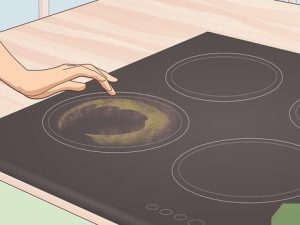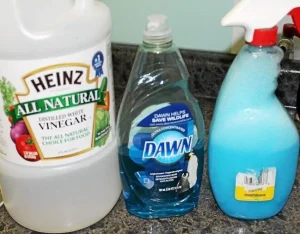Updated on March 12, 2023
Using three parts baking soda and one part warm water, make a paste that may be used to clean an electric stove. In this article, we’ll walk you through the five-step procedure of cleaning an electric stove.
If you don’t know how to properly clean an electric stove, it might be a bit of a challenge. In recent years, more and more of them feature glass stove tops, which necessitate a bit more attention during the cleaning procedure in order to avoid scratching the surface.
How Do You Clean a Burnt Electric Stove
Use a paste of baking soda and vinegar to erase burn marks from your electric stove. Baking soda and water alone won’t be powerful enough to hold this mixture together. 2 parts vinegar and 1 part baking soda are all you need to make this.

In order to soften burn marks on your stove, use vinegar, which is acidic, in combination with baking soda, which is basic.
Scrubbing the cooktop directly should be avoided in order to prevent any scratches.
The paste can be applied again and again if you have difficulty removing the burn marks after allowing the paste to sit for a few minutes.
Step-by-step guide – how to clean an electric stove
1. Remove stove coils and drip pans. If your electric stove does not have coils, skip to step 2.
For electric stoves with coils, remove them before cleaning. Set things aside for now. To clean your stove’s coils, check out our complete step-by-step instructions here.
Once you have checked out the information and had a chance to clean your stove coils, proceed on to step 2.
Don’t worry; keep reading and we’ll describe how to clean your stove drop pans later in the article.
2. Apply a baking soda paste to the stove top.
Three parts baking soda and one part water can be used to form a paste of baking soda. Make a warm water paste for optimum results. Faster removal of grease from your stove will be achieved by using this method.
3. let it sit for a few minutes.
For the baking soda to do its job, you’ll need to let it sit for two to five minutes.
4. Wipe the area with a towel.
After a few minutes, use a cloth to wipe the area clean. You don’t want to scratch the stove’s surface by violently washing it with baking soda.
How Do You Maintain a Stove Burner
Wipe Down Daily, Scrub Weekly, Deep Clean Monthly
You probably already know the basics of stove cleaning at home. Using a light cleaning solution, wipe it down when it’s cooled down a bit (warm is good).
When it’s safe to do so, attempt to clean up any spills or leaks as soon as they occur. You can avoid some of the greatest messes and lessen the amount of scrubbing later by following this popular practise.
The grate and the surface beneath it should be scrubbed at least once a week to keep grease from accumulating. Every month, or at least twice a year, thoroughly dismantle your stove and soak/scrub each and every component.
The rest of it is merely window decoration, and you’re probably already familiar with it. The maintenance of gas and electric stoves differs, however there are some helpful ideas we can offer.
Use Vinegar and Dish Soap as Your Cleaning Solutions
When it comes to cleaning your gas stove, vinegar and dish soap are the best options. Dish soap is a medium-strength base, whereas vinegar is a moderate, non-toxic acid.

Your cooking grate and stove components will be completely clean after using them in combination. Hazardous gas elements can be damaged, your stove etched, or your home made more toxic by using stronger chemicals like stove cleansers.
You can use hot water and vinegar or dish soap to clean your stove unless the task calls for something different.
Soak and Scrub the Grate Once a Month
We’ll start with some advice for your frying grate. Gas burners, unlike electric stoves, require a small distance between the flame and the bottom of the pan.
A big enamelled grate covers the stovetop instead of individual burner grates in most domestic and many commercial gas stoves Individual grates on gas burners are becoming more prevalent, but this is not always the case.
Start with a soak if you have a gas burner with a grate (or multiple grate). While you clean the remainder of the stove, fill your sink halfway with hot, soapy water and soak the grates for up to forty minutes.
Because most stove grates are too large to soak in the sink all at once, flip the grates halfway through.
What Is the Easiest Way to Clean a Stove Burner
Step 1
You should not proceed any further until the burners have cooled fully. For a gas range, remove the grates or burner coils (for an electric range). A simple tug and raise motion is all that is required to remove the coils from the stove’s heating elements.
It’s best to consult with your appliance manual if those coils refuse to budge. Afterwards, remove the grates or coils and place them on a counter to be cleaned.
Step 2
Fill a basin halfway with warm water and a small amount of dish soap. Scrub the burners after dipping a cloth or sponge into the solution.
It’s better to prevent getting the sockets on your electric range wet.) If you’ve recently cleaned the burners, this method may work for you.
Step 3
Use the abrasive strength of baking soda to remove more stubborn stains. You can use baking soda mixed with water to make an extremely thick paste. Allow the paste to sit on your burners for around 20 minutes before using.
Caked-on residue should be soft enough to remove with a sponge after that time has gone. Once the paste has been removed from the burners, rinse them thoroughly to remove any remaining residue.
Step 4
There’s one more method to try if the two above don’t do the trick. Put a quarter-cup of ammonia in each plastic bag with the burners. Rather of covering the burners in ammonia, the idea is to suffocate them.
Be prepared for any leak by leaving the bags in your sink overnight. Open the bags the following day, ensuring that the kitchen is properly ventilated, and wipe down the burners with a sponge.
Remember to properly rinse the burners once the residue has been removed to eradicate all signs of ammonia.
Step 5
Allow the burners to air dry after wiping them down with a clean cloth or paper towel. Make assured that the stove sockets and the coils are totally dry before reconnecting the electric range’s coils.

